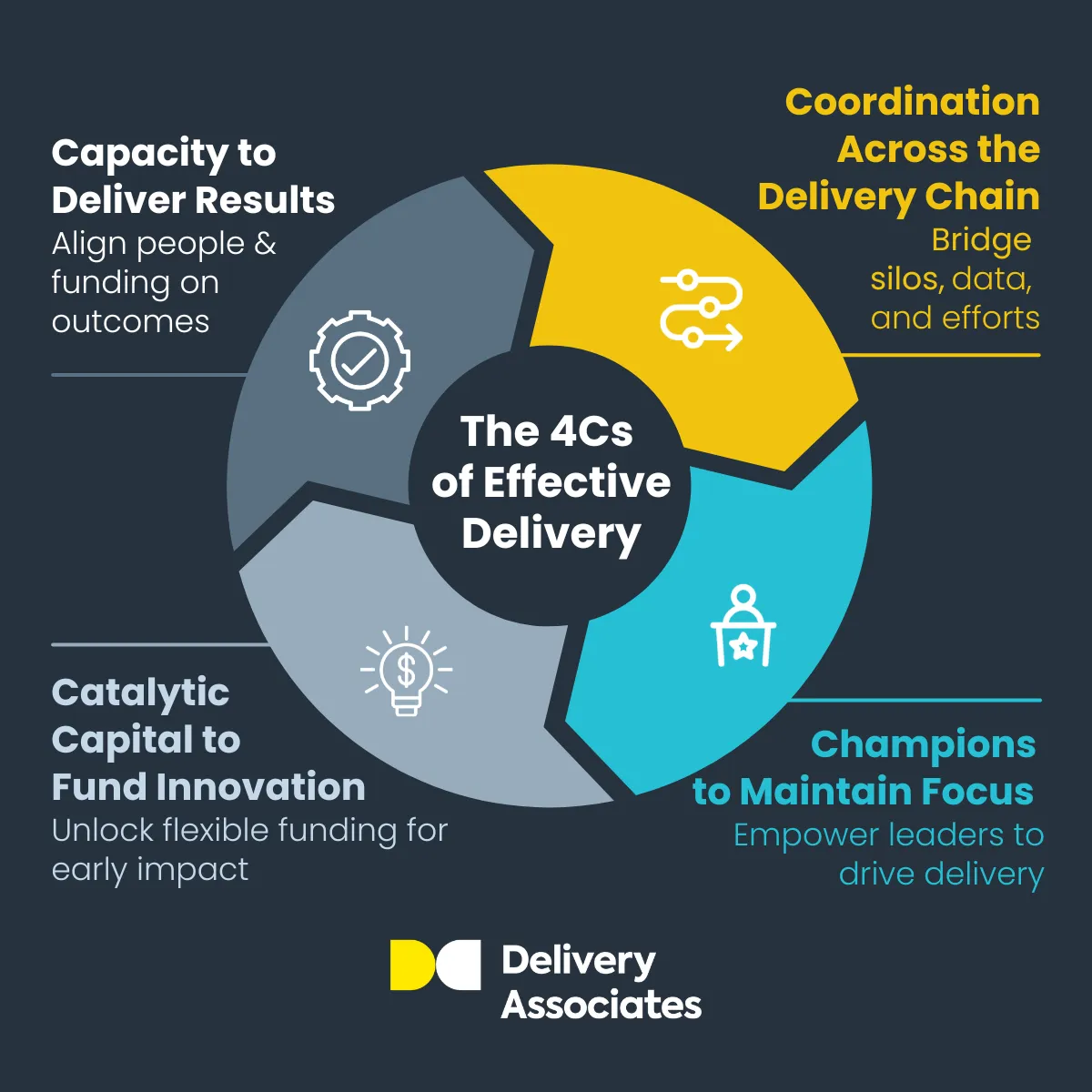What U.S. State Governments Need Now
The 4Cs of effective delivery
A Pivotal Moment for Governments
As Congress enacts major cuts to numerous domestic programs, and the federal government shifts more responsibility away from DC, the delivery of essential services millions of Americans rely on across education, healthcare, workforce development, housing, and more is changing. At the same time, state and local governments will likely receive less funding for many of these programs than they have in the past, meaning they’ll have to do more with less. Trust in government is low, and the gap between citizens’ expectations and government performance is widening.
To deliver for their citizens and communities, states will need to step up in new ways.
Few of today’s complex problems can be solved with a single leader or agency tasked to drive results: Many if not all require coordination across multiple domains, leaders, and funding streams. It’s complex work, and it will be more complex for many states in a constrained funding environment.
But this moment also represents an opportunity—to build trust, to improve delivery, and to reimagine what’s possible when leaders focus relentlessly on outcomes that matter. In our decades of work in government, we’ve seen firsthand the importance of effective delivery, especially during periods of government transition or change.
From this work, we’ve observed four key enablers—which we call the 4 Cs—that build the conditions for delivery at the state level. These four insights provide a roadmap for state leaders, as well as their partners in the business community, civil society, and philanthropy, to meet the moment.
The 4 Cs States Need for Effective Delivery
1. Capacity to deliver results
While the federal government has unique fiscal tools, such as the ability to print money, borrow without limitation, and no requirement to balance its budget, states do not. They operate with significant financial management guardrails and restrictions, which often translates into lower budgets and lower capacity. State governments need financial resources to fund new programs, hire staff, and provide relied-upon services. Simply put, they need capacity to support delivery, and it’s often in short supply.
Some of this is about budget size, but it’s often about much more. It’s about whether governments have the people, systems, and skills to follow through. This includes institutional knowledge, technical expertise, a delivery-focused mindset, and administrative processes that enable progress.
What would it take to build and leverage capacity around delivery and outcomes rather than compliance, proceduralism, or fiscal constraint? The most important requisite is a mindset shift—from tracking rules to tracking results. Before governments can deliver, they must first see it as part of their role.
In practice, capacity to deliver means:
- Having the right people in the right roles. People bring unique skills and insights that, when matched with the needs of a specific position, move things along faster and more effectively.
- Investing in staff development, especially in areas like AI and data use. Prioritizing upskilling ensures teams are equipped to deliver on priorities.
- Utilizing delivery tools and systems to stay focused on outcomes. Our approach includes setting clear targets, tracking progress, solving problems early, and course-correcting quickly.
- Getting the right governance infrastructure in place. This means convening the right people around the table at the right intervals and reviewing the right data to make decisions that will drive implementation forward. As one governor we worked with put it, "It’s about the chief executive being at the center of a recurring cadence of collaboration and actions that drive the ball down the field every two weeks, every two weeks, every two weeks.”
Examples in Action:
- We’re working with one county to develop a pipeline of implementation talent to deliver on key government initiatives. This work has required a deep understanding of local government processes, activated leaders who see the needs and champion the change, and, ultimately, revisions to outdated hiring classifications and processes. As a result, the team was able to bring on a person to lead a new mental health service.
- We recently supported one state governor’s office in building tool guides to roll out performance management and people development processes—helping staff strengthen their capabilities and grow in their roles.
2. Coordination across the delivery chain
There are many stakeholders along the path from program design to impact for people, and effective coordination among them is essential. As state agencies’ roles evolve, their place in the chain will also shift, making cross-government coordination more important than ever.
To coordinate successfully, state governments must:
- Bridge silos across agencies, between state and local government, and with community partners.
- Align on metrics and data infrastructure.
- Plan and budget coordination efforts intentionally.
- Build a shared plan and vision across delivery partners.
Examples in Action:
- We partnered with the Department of Education and Treasurer’s Office in one state to establish cross-agency routines and co-design new high school diploma requirements. Together, we developed a shared implementation plan and strengthened their capacity to coordinate on key cross-agency initiatives.
- We supported a governor’s office in designing a strategy to ensure state agencies were collaborating with local community place-based partnerships—connecting state leaders, local government stakeholders, and local community leaders most focused on improving communities’ economic mobility and success. We also helped establish a pilot program in which non-education agencies work directly with schools to offer school-based service delivery, like benefits sign-ups, to help create more client-centered services in the community.

3. Catalytic capital to fund innovative initiatives
Nearly every government dollar is programmed for a specific use, with little flexibility. The need to do more with less only makes the problem more acute. For example, states have been asked to take on a larger role in determining Medicaid eligibility and benefits, yet have fewer administrative dollars with which to do it.
To meet these growing responsibilities, states need access to flexible, early-stage funding that can support the experimentation necessary to adapt to new realities, build capacity, and make the case for longer-term investment.
These funds may include philanthropic investments or pooled funds set aside by the legislature. Even modest funding, used innovatively, can go a long way. Once new programs bear results, more permanent funding sources can be taken up by state legislatures and codified into law, policy, and budgets.
Examples in Action:
- In one southern city, philanthropy backed the scale-up of an alternative crisis response pilot. The program was so successful, the state has invested another $800K into it, expanded its coverage, and made it a permanent city initiative.
- Another state used philanthropic investments to support a new approach to reducing child poverty. These funds complemented the state's existing investment, bolstering its ability to bring in expert implementation partners and increasing the probability the program will achieve impact, prove value-add, and secure future additional budget.
4. Champions to maintain focus where it belongs
States need champions to keep delivery efforts on track. Without dedicated leadership, even the most promising initiatives risk stalling or getting left behind.
States can take several key actions to ensure strong leadership and clear roles that keep initiatives moving forward:
- Establish a central leader and champion: Appoint a dedicated leader who’s passionate about changing the part of government they lead—and equipped to drive the work and build coalitions across agencies and jurisdictions. Champions protect the effort’s “why,” and help shift the culture from compliance to performance. As we have seen time and time again, one inspiring leader can transform a department or a system.
- Create and maintain a shared vision: Align stakeholders around common goals to sustain focus and momentum.
- Prioritize leadership at all levels: From executive sponsorship to move initiatives forward, to the ability to bring others along and build coalitions, to driving longer-term reform and institutionalization—strong leadership at all levels matters. This includes empowering those in delivery roles to do things differently and relentlessly focus on outcomes.
- Define roles with intention: Some states may take a top-down approach led by the governor or state agencies. Others may emphasize local control—setting supportive policies, incentives, and funding streams while enabling local organizations to lead delivery. There’s no one-size-fits-all model. What matters is that the state clearly defines its role.
Examples in Action:
- We helped one city form a guiding coalition that bridged siloes between the mayor’s office and police department. The coalition enabled joint pursuit of new investment in and expansion of the city’s alternative crisis response program—showing the power of aligned leadership.
- In another state, we began support for an incoming administration with a Cabinet retreat in the month before they took office. That work eventually extended to strategic planning with the governor’s office, the state office of budget and management, and individual agencies to cascade leadership on delivery at all levels.
What Comes Next
The push for greater delivery and accountability in government is not a passing trend. It’s a permanent shift relevant to every state, regardless of which party controls the state legislature. Republicans hold a majority in the state legislatures of 56% of states, and Democrats in 40%—but the fact remains that all are responsible for getting things done.
This moment presents an opportunity for states to step into new leadership positions, raise the bar on effective governance, and ultimately deliver impact for the people they serve. The 4 Cs—Capacity, Coordination, Catalytic Capital, and Champions—offer a roadmap to do it.
Public trust is essential for good governance, but it’s eroding worldwide. Explore proven strategies and real-world examples to help leaders reverse the trend.




.jpg)
